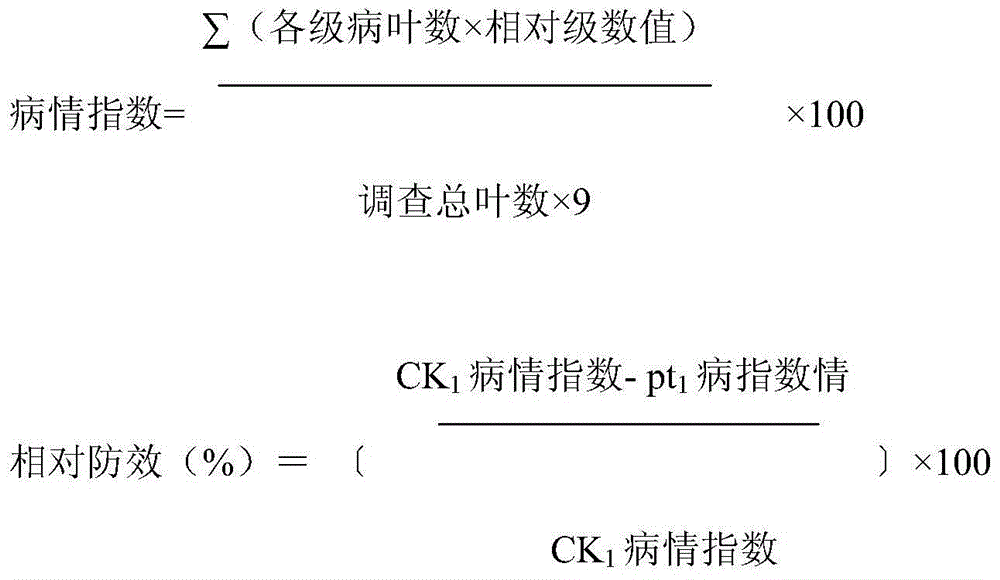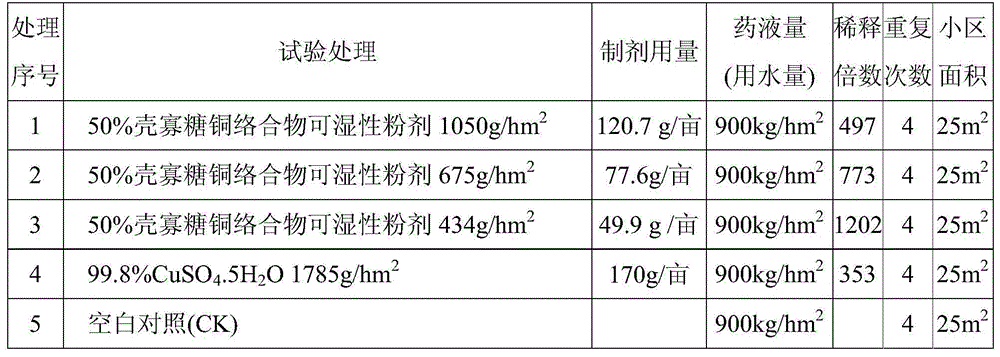Chitosan oligosaccharide copper complex fungicide and application of chitosan oligosaccharide copper complex fungicide
A technology of copper complexes and chitosan oligosaccharides, which is applied in the direction of fungicides, applications, biocides, etc., can solve the problems of safety hazards, drug resistance, etc., and achieve significant control effects, robust growth, and reduced use.
- Summary
- Abstract
- Description
- Claims
- Application Information
AI Technical Summary
Problems solved by technology
Method used
Image
Examples
Embodiment 1
[0019] 1. Production of chitosan oligosaccharide copper complex:
[0020] A. According to different molecular weights, add a certain amount of deionized water to chitosan oligosaccharide, stir evenly, add copper sulfate, dissolve and stir uniformly, form 1% chitosan oligosaccharide copper complex (according to the total mass of chitosan oligosaccharide and copper ion meter) solution. The mass ratio of chitosan and copper ions is 1:1. The above 1% chitosan oligosaccharide copper complex solution was used in Example 2 to verify the indoor effect on plant pathogenic bacteria.
[0021] B. The solution containing a certain amount of copper ions, according to the molecular weight of chitosan oligosaccharides and water solubility, add water to fully stir and dissolve to form a chitosan oligosaccharide copper complex solution. The mass ratio of chitosan and copper ions is 2:1.
[0022] 2. 10% chitosan oligosaccharide copper complex water
[0023] Add chitosan oligosaccharides with...
Embodiment 2
[0028] Embodiment 2 Chitosan oligosaccharide copper complex is to the indoor effect verification of plant pathogenic bacteria
[0029] 1. Experimental method
[0030] Plate inhibition zone method was used.
[0031] 1) Test equipment: aseptic operating table, sterilizing pot, biological incubator, shaking table. PDA medium, sterile water.
[0032] 2) Test method: first, transfer the pathogenic bacteria of Zingiberella gingivalis into the PDA liquid medium, and after culturing for 30 hours, draw 100 microliters onto the PDA plate and spread evenly. Use a hole puncher to punch holes (aperture D=0.6cm) on the culture medium coated with pathogenic bacteria. Then inject 50 microliters of test solutions (1% chitosan oligosaccharide copper complex and 1% copper sulfate solution prepared in Example 1) into the holes respectively.
[0033] They were cultured in a biochemical incubator at 28°C, and each treatment was repeated 4 times. The investigation was started at 24 hours, and t...
Embodiment 3
[0041]Example 3 The verification of the effect of chitosan oligosaccharide copper complex water agent on the control test of cucumber horn spot disease
[0042] Cucumber bacterial angular spot (Pseudomonassyringae pv. lachrymans Smithet Bryan. Yong, Dye & Wilkie) is a bacterial disease. Pseudomonas syringae pathogenic type of cucumber angular spot is one of the important diseases on cucumber, and the pathogen survives the winter in the seeds, outside or with the diseased residues in the soil. The pathogen spreads in the field through irrigation, wind and rain, airflow, insects and agricultural operations, and invades the host through stomata, wounds and water holes. The humidity is high, the disease is severe, and the disease is easy to spread after the storm. Bacterial angular spot produces needle-like water-soaked lesions on the back of the leaves, often dozens of lesions occur at the same time.
[0043] 1. Test materials
[0044] 1. Drugs to be tested
[0045] 10% chito...
PUM
 Login to View More
Login to View More Abstract
Description
Claims
Application Information
 Login to View More
Login to View More - Generate Ideas
- Intellectual Property
- Life Sciences
- Materials
- Tech Scout
- Unparalleled Data Quality
- Higher Quality Content
- 60% Fewer Hallucinations
Browse by: Latest US Patents, China's latest patents, Technical Efficacy Thesaurus, Application Domain, Technology Topic, Popular Technical Reports.
© 2025 PatSnap. All rights reserved.Legal|Privacy policy|Modern Slavery Act Transparency Statement|Sitemap|About US| Contact US: help@patsnap.com



